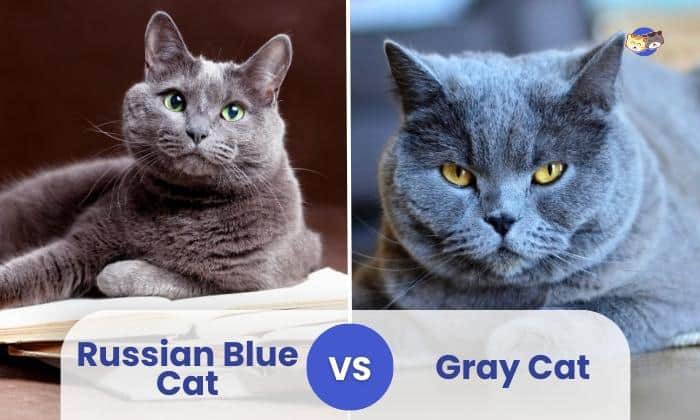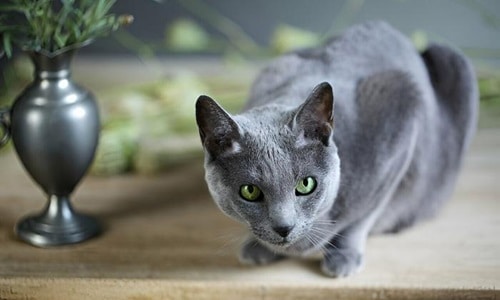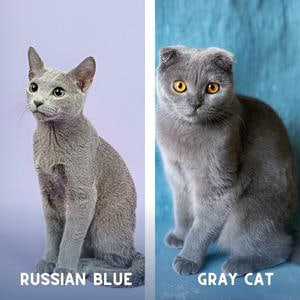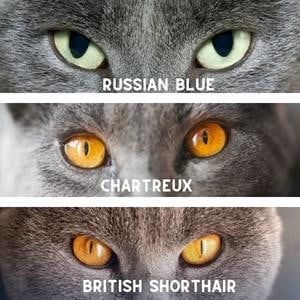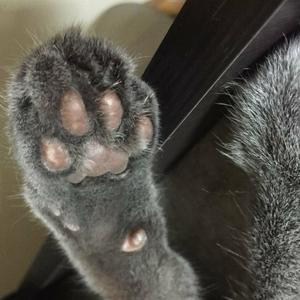The Russian Blue Cat is a popular cat breed throughout the world. Despite the name, the Russian Blue aren’t actually real blue cats.
Instead, they are dark gray with a hint of silver on the tips of their fur, making them pretty easy to differentiate from your domestic shorthair, unless, of course, your feline is of another similar breed like British Blue or Chartreux.
To help you with identifying these precious felines, below is a table showing some features of the Russian Blue vs gray cats.
| Russian Blue | Gray Cats |
| Dense fur coat | Coat can be thin. |
| Dark Gray fur with white tips | No white tips |
| Pink paw pads | Paw pads can be different in color. |
Table of Contents
How Do You Identify a Russian Blue Cat?
It’s no surprise that many people end up confused when discussing cats. Unlike dogs, which are very distinguishable in terms of their breed, many people tend to confuse one cat type with another.
Sometimes, a Russian blue mix cat can be mistaken for a pure Russian Blue.
As stated by feline enthusiasts on Reddit:
Is my cat a Russian blue? People always ask me if austin is a Russian blue and i can never give them an answer since he was a rescue and we don’t know his breed. What do you all think?
byu/haleyymt inrussianblue
That being said, how do you know if your cat is a Russian blue? Here are some indicators.
1. Personality
The Russian blue’s personality is an interesting thing to consider. They are very curious cats, but aren’t rowdy and love a good amount of play with their owners.
They are very smart and affectionate cats but can spend time at home by themselves for long periods.
Like other cats, however, they aren’t so tame as to just allow you to pick them up at your leisure. You have to wait for your Russian Blue to come to you and ask for affection.
So, if your feline is very friendly towards strangers and new pets, it may not be a Russian Blue. This breed also tends to be quiet, unlike some other species such as the Oriental Shorthair (which can also have gray fur).
2. Physical Attributes
One of the best ways to identify a grey cat vs Russian blue is through their physical attributes.
- Russian blue kittens are typically deep gray in color with white tips on their fur. This is also true for adult Russian Blues, with their fur typically denser than most other cat breeds.
Regular gray cats may exhibit identical coat colors, but they lack the silver tips prominent in Russian Blues.
- Russian Blue eye color is also typically green, while other gray felines mostly have different eye colors (such as copper for Chartreux and British Shorthair).
- Their paw pads are light pink or mauve, though the shade may vary among individual Russian Blues, with some having darker or lighter paw pads.
- Russian Blues are typically lean and muscly. In size comparisons with other felines, these pets are average (measuring 9 to 11 inches in height and 7 to 12 pounds in weight). If your gray cat is exceptionally big, it probably belongs to another breed.
- Russian Blues also have an almost shimmery hue, which comes from how their fur grows. Typical gray-colored cats usually just have monotone coloring.
- Other features to look out for included a wedge-shaped head and a straight line with no break from the nose tip to the forehead. Cats without these features are not Russian Blues.
What Makes the Russian Blue Particularly Special?
Many people are allergic to cats but may still want to have them as pets. Typically, all cats, not just gray ones, tend to shed a lot of fur, releasing the allergenic protein called Fel D1, causing the allergic reactions many people have.
Purebred Russian Blues, with their short and puffy coat with white markings, shed very little hair, in turn generating less Fel D1 to cause irritation. For this reason, Russian Blue cats may be suitable for individuals with moderate sensitivity to fur.
User rusty_mullet from Reddit shared his experience in regards to living with a Russian Blue while having allergies. Surprisingly, he did not experience flare-ups like with other cats.
Russian blues also tend to be very low maintenance when paired with good hygiene, as their short fur length makes it easy to take care of them. They are also calm and gentle by nature, making them good to pair with dogs and other pets.
Conclusion
The Russian Blue vs gray cat discussion is pretty common since the former can be tough to distinguish from the latter.
That being said, with the information above, the next time someone asks, “Is my cat a Russian Blue or just gray?” you should probably take a look at the feline and see if it has Russian Blue eyes, a wedged head, mauve paws, and silvery tips.

I pursued veterinary studies at the University of Kansas. After several years of practice, I established a veterinary clinic in Kansas. When Michael extended an invitation with a vision that went beyond emergency support – sharing of caregiving information for guardians to create the best living environment for cats, I didn’t hesitate to join the organization.
My role here involves verifying the information presented on the official website. With my experience, I believe the information provided is entirely accurate. If you have any concerns, please feel free to reach out to me


